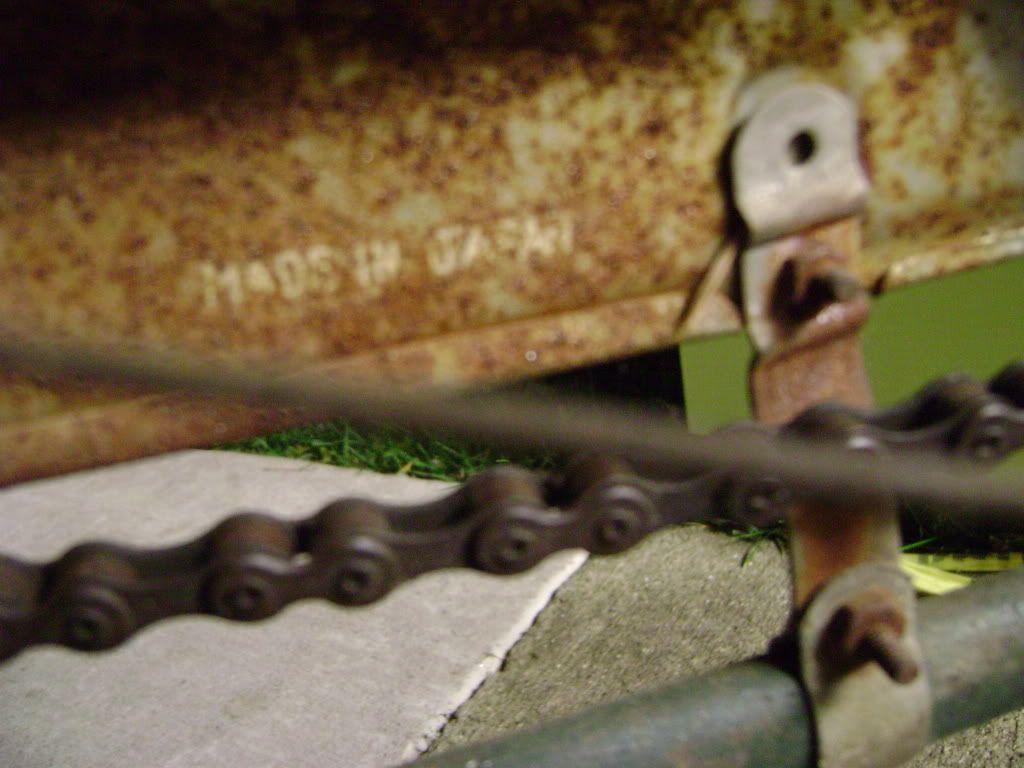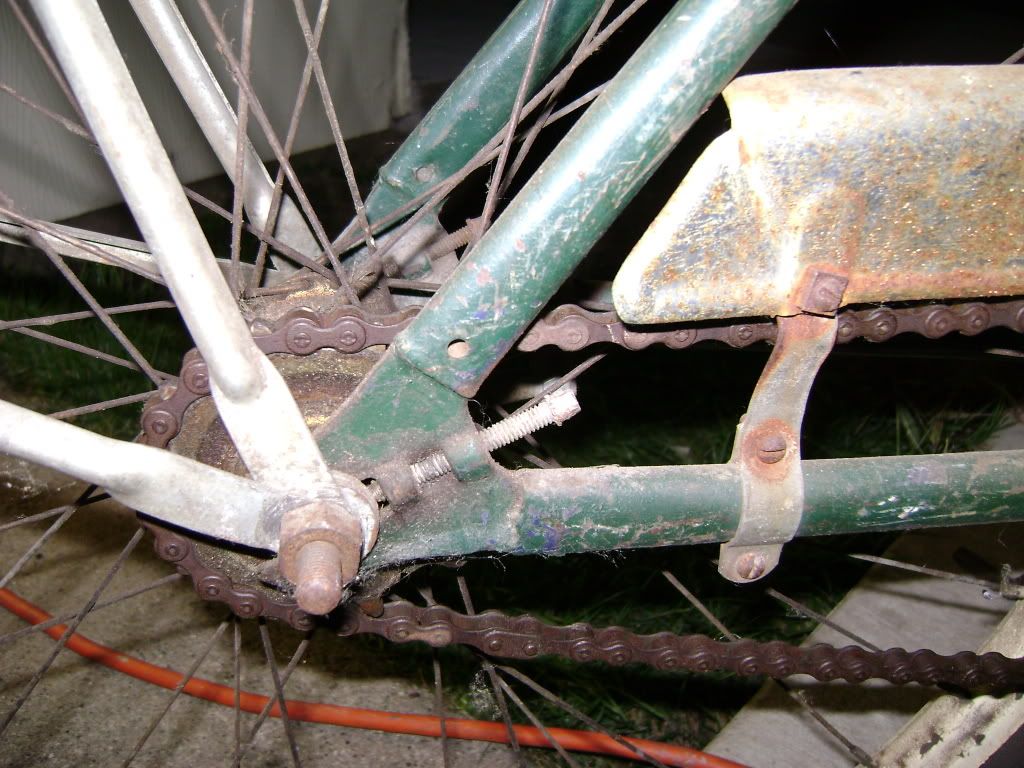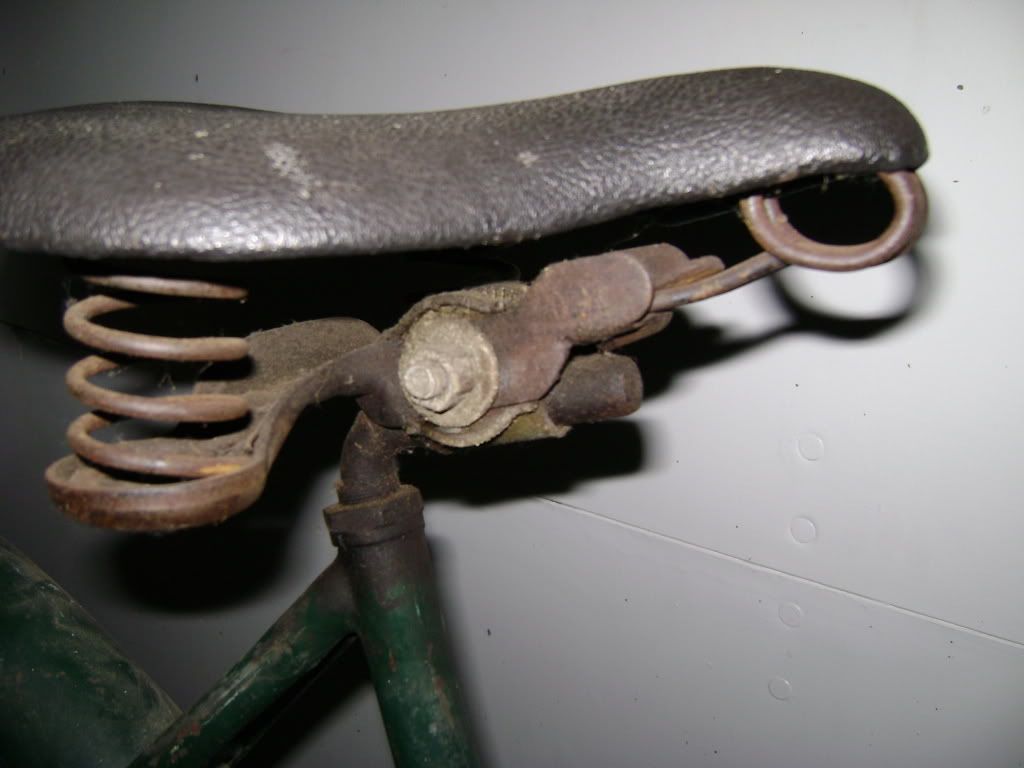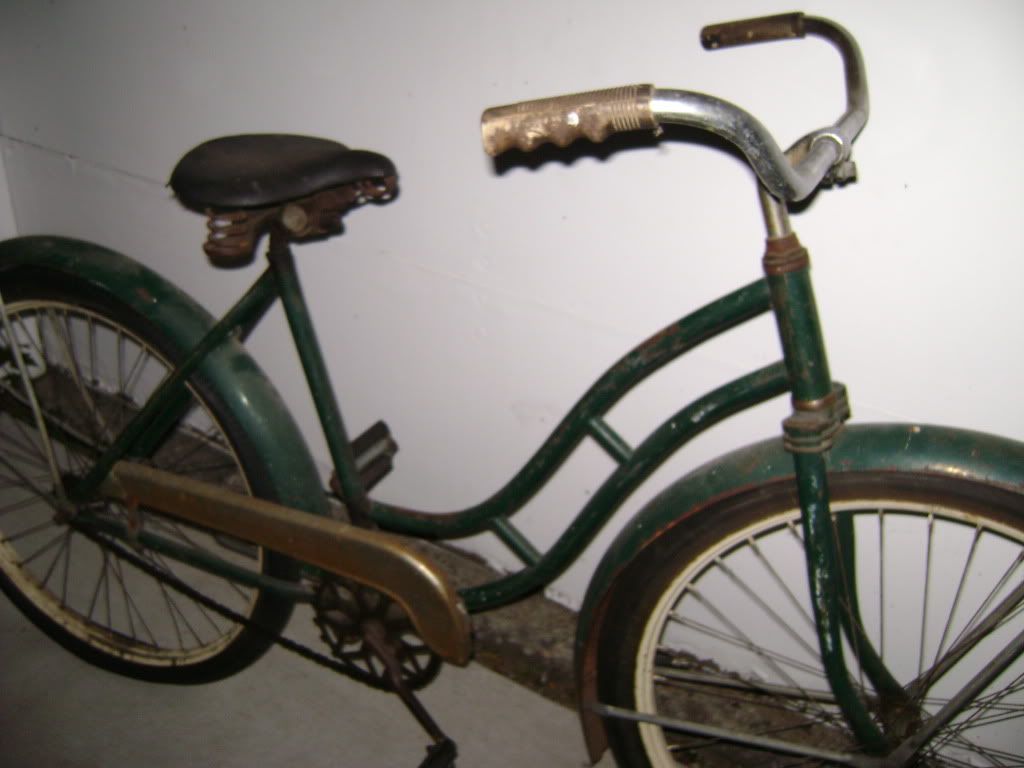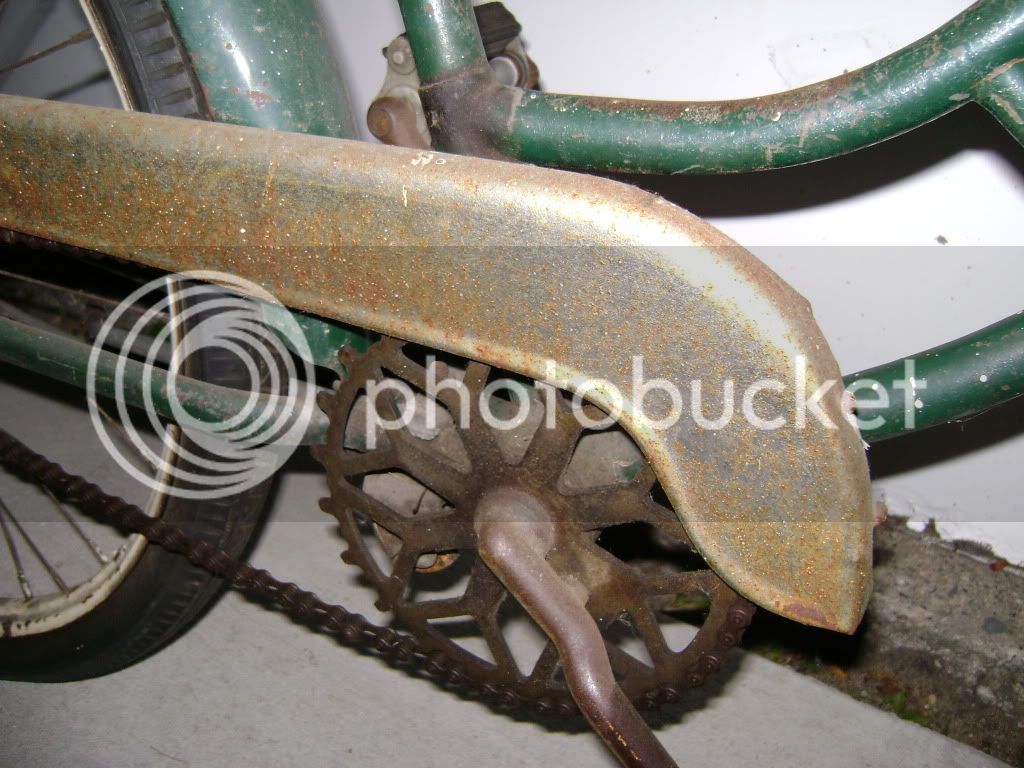Last nite I got home before dark and kids wanted to go for bike ride. So last min.we went son loves tag along behind flightliner. Made it 5 blocks and some old friends liked the bike and had us stop to look then he told me to come back and take a bike off his porch that's been there for 10 years. Its a skip tooth womens. Serial number hard to read but appears to be 1948 sept 23. If I'm reading them right. Has a model d rear hub sprocket made up of diamond shape cutouts 5 I think with little triangles between them. Seat post make 90 bend to seat but what's odd to me is it appears to be threaded not clamped has big nut type setup on bike frame that post threads in to ? Also what was strange chrome chain guard on back side reads made in japan. I will post pics sat. No markings that I can see but is all there all painted green wheels white. Seat has 3 springs. 1 in front 2 back like a texured mat but I don't think is leather. Rear drop outs have adjusting screws on them. Thanks for the help RBonney
You are using an out of date browser. It may not display this or other websites correctly.
You should upgrade or use an alternative browser.
You should upgrade or use an alternative browser.
1940s Skip tooth bike womens
- Thread starter rbonney
- Start date

Help Support Rat Rod Bikes Bicycle Forum:
This site may earn a commission from merchant affiliate
links, including eBay, Amazon, and others.
- Joined
- Aug 3, 2010
- Messages
- 12,545
- Reaction score
- 2,899
Post some pics if you can, I have never seen anything like it, you might have a real gem there.
I will try to get pics soon. The sprocket is 1 piece I was trying to explain the cut outs in it. Also the crank arm on sprocket side bumps out alittle after the first couple of inches other side crank arm is straight. It has white grips with a small printed name maybe like hund company or corporation hard to read. The serial number chart I used was schwinn. Thanks for your help
- Joined
- Aug 3, 2010
- Messages
- 12,545
- Reaction score
- 2,899
Sounds really interesting.
she sounds just like my daily rider does she look like this kinda?
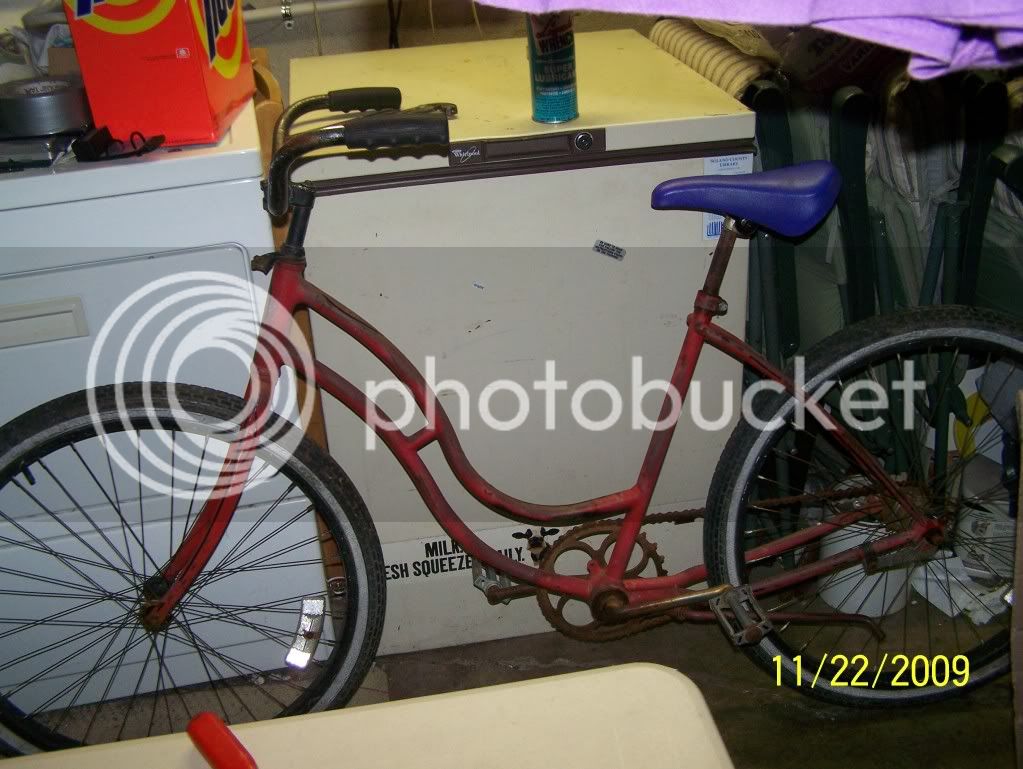


Look very close on the womens bar that comes down it has a second support about 7 inches under the first. Sprocket has diamond shapes 7 of them and triangels inbetween. Troxel seat but frame is threaded for seat post. Just took pics will try to post. Thanks RBonney

$19.99
Electra Glide Wall Decal 2ft Long Sport Harley Davidson Bike Motorcylce Sticker Man Cave Garage Boys Room Decor
FatCat Wall Graphics

$24.99
Top Brass Bicycle/Motorcycle Chain Picture Frame 5" X 7" Photo - Faux Bike Chain
Old River Outdoors (USA Merchant)

$34.99
Bicycle/Motorcycle Chain Picture Frame 8" X 10" Photo - Faux Bike Chain Vertical or Horizontal Table Top Display
Old River Outdoors (USA Merchant)
- Joined
- Aug 3, 2010
- Messages
- 12,545
- Reaction score
- 2,899
wow man, that seat is awesome, I've never seen anything like it. I'd say clean it up, flip the bars, and turn the seat post around so it moves you back a bit and board-tracker it.
I was waiting for pictures to confirm what I thought based on your description of the seat binder. The bike was made by the H. P. Snyder Company of Little Falls New York and the seat binding mechanism dates the bike as a 1936 model, the only year that binder was used. The frame, fork headset and crank and sprocket are original to the bike. The wheels may also be original but the fenders, the chain guard, the seat, and the bars and stem were all changed out at some later time.
The seat binder is a locking collet affair; to adjust the seat you loosen the top nut (counter-clockwise to loosen) and adjust the seat post to the desired height then retighten the nut. Since it has been sitting I would apply penetrating oil before trying to adjust it.
The seat binder is a locking collet affair; to adjust the seat you loosen the top nut (counter-clockwise to loosen) and adjust the seat post to the desired height then retighten the nut. Since it has been sitting I would apply penetrating oil before trying to adjust it.
So you would call this a 36 for year? Do you think it lost its badges? What do I tell the guy who gave it to me? I may be seeing blue paint under some of that green. What should I do with it next how do I clean it? This is all new to me. Thanks for your help.
- Joined
- Aug 3, 2010
- Messages
- 12,545
- Reaction score
- 2,899
I have had good luck with gasoline and an sos pad to remove spray paint. Works great as a lot of kids don't prep the surface first.rbonney said:So you would call this a 36 for year? Do you think it lost its badges? What do I tell the guy who gave it to me? I may be seeing blue paint under some of that green. What should I do with it next how do I clean it? This is all new to me. Thanks for your help.
It is definitely a 1936 Snyder built bike. It would have been badged but there are many different badges that were applied to these bicycles so knowing for sure how it was originally badged will be difficult. The location of the holes for the head badge may help but those too are somewhat generic. Cobalt blue was a standard color used by the Snyder company and a lighter blue was also available. The bike as it stands is not a particularly valuable model nor does it build into one so you can feel free to clean the bike up and use it or repaint it as you like without the fear of hurting the value of a rare collectible.
Thanks for the help. I think this would work good for the wife. All she wanted was a bike with a basket and I refuse to put a basket on her spaceliner. Does anyone haven pics of how they looked? Thanks RBonney
Here are a couple of reference photos of similar Snyder built girl’s bikes on Dave Stromberger’s site. The first is also a 1936 bike with the collet seat binder and there are several more photos of the bike on the site. The second bike (blue) is listed as a 36 but it is not, it is more likely a 1938 but still uses essentially the same frame in front but with an updated rear with curved seatstays and without the collet. The Blue bike shows a version of the tank that was used on these bikes.
http://www.nostalgic.net/index.php?s=ar ... dies+1.jpg
http://www.nostalgic.net/index.php?s=ar ... Ladies.jpg
http://www.nostalgic.net/index.php?s=ar ... dies+1.jpg
http://www.nostalgic.net/index.php?s=ar ... Ladies.jpg
Phil, wasn't that snowflake chainring used mainly on Ward's Hawthornes? I don't recall seeing it on other Snyder built bikes, but anything's possible! -Adam
Rustinkerer said:Phil, wasn't that snowflake chainring used mainly on Ward's Hawthornes? I don't recall seeing it on other Snyder built bikes, but anything's possible! -Adam
Hi Adam,
The snowflake was the predominant Hawthorne pattern until it was replaced during 1936 by the comet swirl design. Some chain ring patterns are exclusive to Hawthorne and others are not, I believe I have seen the snowflake used elsewhere but your question had me digging for evidence to back that assumption up and I didn't yield any on my first search!
This brings up another observation and clarification. Obviously, every bicycle was actually built in a specific year (though some components may predate the finished bike by enough time to have been made in the previous calendar year.) To pin down dates of construction we rely on serial numbers if possible and catalog information if the serial numbers have not been adequately decoded. Catalogs provide us with snapshots of a specific specification but don’t map the individual changes as they were implemented on the production lines. Based on catalog information we attribute the collet seat binder to 1936-only for Snyder built bikes. It is possible that the collet entered production in mid to late 1935 as many bicycle manufacturers began producing for Christmas and the next year in the summer and fall of the previous one. The actual date of the transformation back to a standard binder is also up for grabs. By the time the 1937 catalogs were in print it had been abandoned so it may have been replaced before the end of 1936.
Chain ring patterns are the same in that we typically use them to define a year but model year might be a more accurate as an overview and even then, as you say, anything is possible, left over parts were used up sometimes out of sequence.
Much ado about nothing but I always get a little squeamish nailing the exact year of production down for any bike.
I’ll add one more nugget, an assumption (I think, therefore I assume) based on several bikes and catalog information I have looked at. Most of the catalogs show the collet binder as it is on this bike, with a small top nut that begs the question “what do I do with this?” Some bikes that use the collet have a different, oversized top nut the looks like it is formed from a folded piece of thick plate. Again, based on observations, I believe the oversize nut is a later improvement designed by Snyder to give something more substantial to put a wrench on and to symbolically suggest what to do for consumers confused about how the system functions.








































